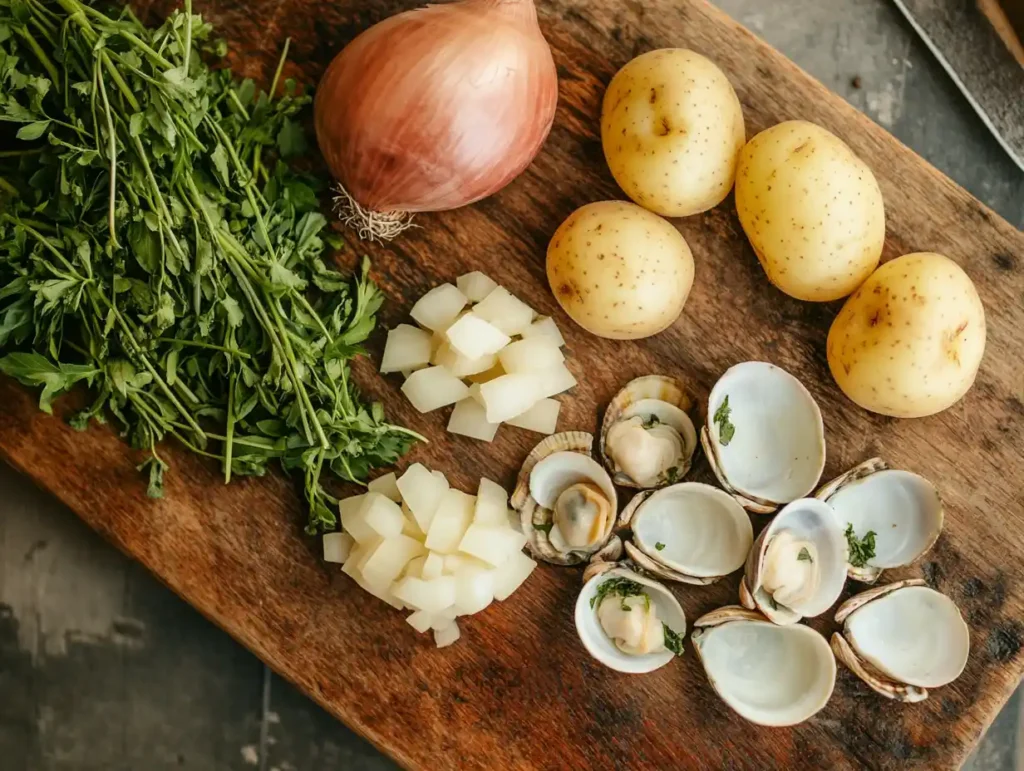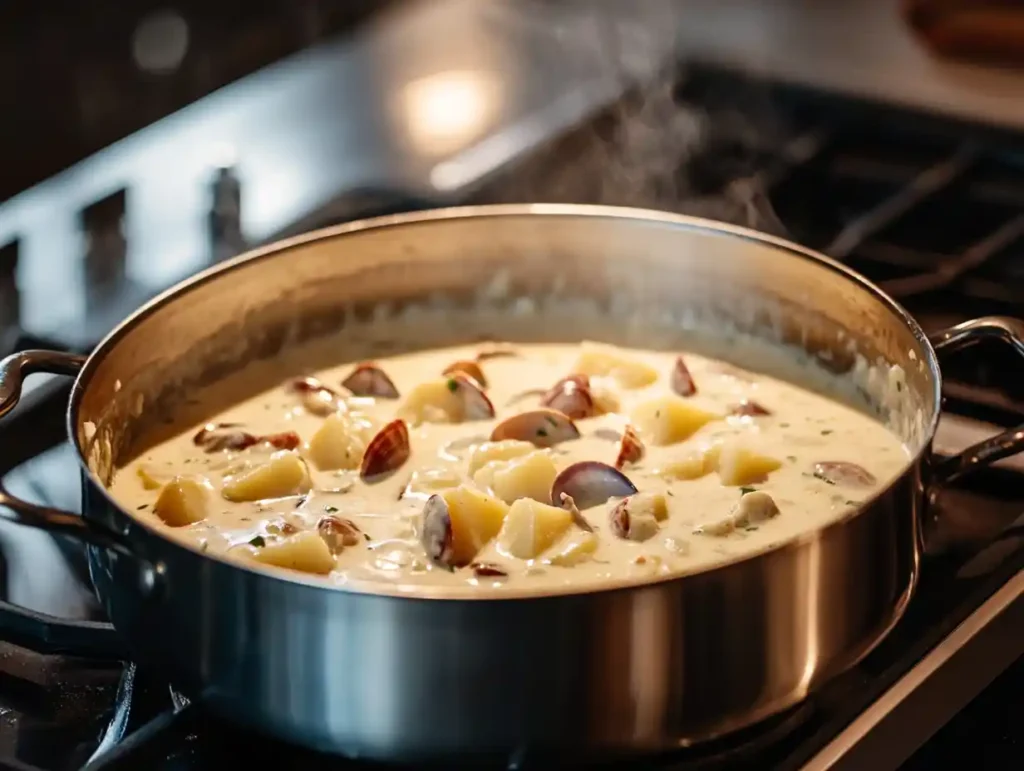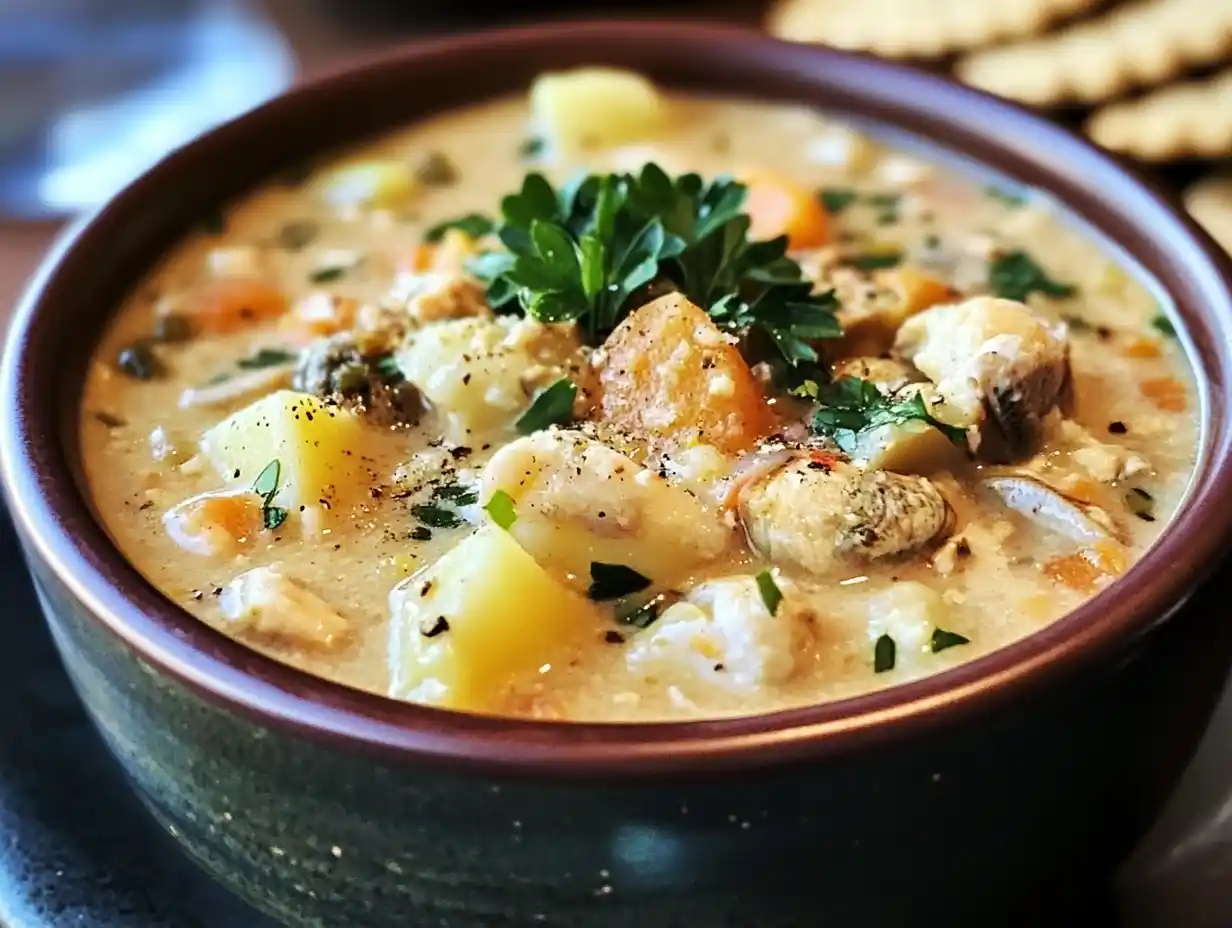A dish that many people love for its warmth and rich flavor. It’s a thick soup or stew that stands out because of its creamy texture and hearty ingredients. But what makes it different from other soups? Is it the cream, the seafood, or the cooking method? This article will explain what makes chowder unique, explore its history, and reveal why it’s a favorite for so many.
Whether you enjoy a classic New England clam chowder or a simple corn, all chowders share some key traits. They are rich, flavorful, and satisfying. Let’s dive into what makes this dish special, how people make it, and why it plays an important role in many cultures.
Chowder does more than taste good—it brings comfort and joy. Families often serve it at gatherings or on cold nights. Its flexibility allows people to use local ingredients and adapt it to their tastes. From New England to Ireland,it continues to warm hearts and bring people together.
Defining Chowder
Chowder is not just a soup; it has distinct characteristics that set it apart. Its thick, creamy consistency and hearty ingredients create a satisfying meal in every bite. While people often associate it with seafood, especially clams, its definition goes beyond that. Different cultures and regions have their own versions, which incorporate local flavors and ingredients.
The Origins
The word “chowder” is believed to come from the French word chaudière, which refers to a pot used for cooking stews. French fishermen are thought to have brought the dish to North America in the 18th century. Over time, it evolved as cooks added local ingredients like clams, potatoes, and corn. Early versions were simple and made with a mix of seafood, biscuits, and vegetables cooked together in one pot.
New England became one of the most famous regions for chowder. The area’s abundance of clams and dairy made it the perfect place for developing the creamy, clam-filled version we know today. This traditional dish spread across the United States and the world, inspiring countless variations.
The Key Ingredients
Classic chowder recipes share some staple ingredients, though variations exist. Most include a base of milk, cream, or broth to achieve the dish’s signature thickness. Potatoes and onions are common vegetables, adding both texture and flavor. Proteins like clams, fish, or chicken often serve as the main ingredient, though vegetarian options are also popular.
Thickeners like flour or crackers are essential in traditional chowder. They create the creamy consistency that defines the dish. Herbs and spices, such as thyme, parsley, and black pepper, add depth to the flavor. These ingredients may seem simple, but together they form the rich, satisfying dish that his fans adore.
Traditional vs. Modern Interpretations
While traditional chowders stick to time-tested ingredients and methods, modern interpretations take the dish in new directions. Some cooks experiment with non-dairy alternatives like coconut milk or almond milk to cater to dietary preferences. Others incorporate bold, unexpected flavors, such as smoked paprika, bacon, or even spicy peppers.
Vegetarian and vegan chowders have also gained popularity, replacing seafood with hearty vegetables like sweet potatoes, cauliflower, or mushrooms. These variations retain the comforting essence of chowder while appealing to a broader audience.
Characteristics

What truly makes chowder stand out? Several key characteristics define this dish and make it recognizable, even with its many variations. From its thick, creamy texture to its mix of hearty ingredients, chowder has a distinct identity in the culinary world.
Thick and Creamy Consistency
The thick and creamy texture is perhaps chowder’s most defining trait. Unlike many soups, which are often light and brothy, chowder uses milk, cream, or a roux to achieve a rich, velvety consistency. Thickeners like flour, cornstarch, or crushed crackers are also common additions to ensure the dish has body and substance. This texture makes chowder feel more like a full meal than a simple appetizer.
The creaminess isn’t just about appearance—it’s a crucial part of the dish’s comfort factor. The richness of the broth coats the ingredients and enhances their flavors, creating a satisfying experience with every bite.
Use of Milk or Cream
Chowder traditionally relies on milk or cream as a key ingredient. These dairy products provide the base for many classic recipes, particularly New England clam chowder. The cream gives the dish its signature white color and smooth texture, making it distinct from other soups or stews.
In regions where dairy is less common or among cooks who prefer lighter alternatives, broth-based chowders are also popular. Manhattan clam chowder, for example, swaps the cream for a tomato-based broth, creating a vibrant red color and tangy flavor. This difference highlights how the use of milk or cream plays a significant role in shaping a chowder’s identity.
Inclusion of Seafood or Vegetables
Seafood, especially clams, often takes center stage in traditional recipes. Variations featuring fish, crab, or shrimp highlight the influence of coastal regions where seafood is plentiful. These dishes not only deliver rich flavors but also represent the local culture and natural resources.
Vegetables also play a key role in chowder. Potatoes are perhaps the most iconic, lending their starchy, hearty quality to the dish. Other common vegetables include onions, celery, and corn. In some vegetarian versions, the vegetables take center stage, proving that chowder doesn’t need seafood to be rich and satisfying.
A One-Pot Meal
Chowder is typically prepared as a one-pot dish, which contributes to its appeal as a simple yet hearty meal. By cooking all the ingredients together, chowder allows flavors to meld beautifully. This method also makes it easy to prepare in large batches, making it a popular choice for family meals or gatherings.
Types
Chowder comes in many varieties, each with its own unique ingredients and flavor profiles. While New England clam chowder may be the most famous, other types have also gained widespread popularity. From the creamy classics to lighter, broth-based options, there’s a chowder for every palate.
New England Clam Chowder
New England clam chowder is the quintessential chowder and a hallmark of American cuisine. This rich and creamy soup features clams, potatoes, onions, and a dairy base of milk or cream. The dish is seasoned with simple spices like salt, pepper, and sometimes thyme, letting the natural flavors of the ingredients shine.
This chowder is often served with oyster crackers or crusty bread, making it a comforting and satisfying meal. Its thick consistency and mild flavor make it a favorite across generations. Many coastal restaurants pride themselves on their unique take on New England clam chowder, adding touches like bacon or leeks to enhance the flavor.
Manhattan Clam Chowder
Manhattan clam chowder offers a stark contrast to its New England counterpart. Instead of a creamy base, it uses a tomato-based broth, giving the dish its signature red color. This version is lighter and has a tangier taste, thanks to the addition of tomatoes and often a splash of white wine.
The dish also includes clams, potatoes, and vegetables like celery and carrots. Manhattan clam chowder is spicier and more vibrant in flavor, appealing to those who enjoy a zesty twist on the traditional chowder. Though less common in some parts of the United States, it has a loyal fanbase, particularly in New York and along the East Coast.
Corn Chowder and Other Variants
Corn chowder is another beloved variation that swaps seafood for the sweetness of fresh or canned corn. This vegetarian-friendly option often includes potatoes, onions, and a creamy base similar to New England clam chowder. The natural sweetness of the corn pairs beautifully with the rich broth, creating a dish that is both hearty and refreshing.
Regional Variations
This dish reflects the regions it originates from. In Maine, for instance, lobster variations highlight the area’s love of seafood. In the Midwest, corn-based recipes make the most of the region’s agricultural abundance. Meanwhile, Canadian seafood blends often include scallops, mussels, and haddock, showcasing the rich maritime resources of the Atlantic provinces.
Each version celebrates local flavors while staying true to chowder’s defining traits: thick consistency, rich taste, and hearty ingredients. These regional differences ensure that no matter where you are, there’s a chowder suited to your taste.
How Chowder is Prepared

Chowder may have a simple concept, but its preparation requires attention to detail. The key lies in combining ingredients in a way that creates balance and enhances the flavors. While the exact process can vary depending on the type of chowder, certain techniques and steps are consistent across most recipes.
Base Ingredients and Broth
The foundation of any chowder is its broth. For creamy chowders, the base typically consists of milk, cream, or a combination of both. Some recipes use a roux—a mixture of butter and flour cooked together—to thicken the broth. This method not only adds body to the soup but also creates a velvety texture.
Broth-based chowders, such as Manhattan clam chowder, use tomato juice or a seafood stock as the base. These broths are lighter but still rich in flavor, often complemented by herbs and spices. The choice of base determines the overall character of the dish, whether it’s creamy and indulgent or light and zesty.
Cooking Techniques
Chowder is typically made as a one-pot dish, which simplifies the cooking process and allows the flavors to meld together. The cooking process often begins by sautéing aromatics like onions, garlic, and celery in butter or oil. This step creates a flavorful base that sets the stage for the rest of the ingredients.
Next, the main components, such as clams, fish, corn, or chicken, are added. Potatoes are usually included for their ability to absorb flavor and add a satisfying texture. For seafood chowders, ingredients like clams or shrimp are added toward the end of the cooking process to prevent overcooking. Spices and herbs, such as thyme, bay leaves, or paprika, are added at various stages to deepen the flavor profile.
Serving Suggestions
Chowder is best enjoyed fresh and hot, often accompanied by simple sides that complement its rich flavors. Oyster crackers are a classic choice for creamy chowders, providing a bit of crunch and absorbing the flavorful broth. For broth-based chowders, crusty bread or a baguette is perfect for dipping.
Many people garnish their chowder with fresh parsley, green onions, or a sprinkle of black pepper. Bacon bits or shredded cheese are also popular toppings that add depth and richness to the dish. Chowder is commonly served in a bowl, but some restaurants and home cooks get creative by serving it in a bread bowl for an edible, hearty presentation.
Variations in Cooking Style
Some modern cooks experiment with slow cookers or instant pots to make chowder with minimal effort. These methods allow the ingredients to simmer slowly, creating deep, layered flavors without constant supervision. Others opt for a stovetop approach, which gives them greater control over the texture and consistency of the soup.
Grilled or smoked ingredients can also add a unique twist to traditional chowder. Smoked fish or roasted corn, for example, can elevate the dish with bold, smoky flavors. These variations show how versatile chowder is and why it remains a favorite in kitchens around the world.
FAQs
Is chowder always made with seafood?
No, it can be made with a variety of ingredients. While seafood-based versions like clam or fish are common, many recipes use vegetables, chicken, or even bacon as the main ingredient. Corn and potato chowder are popular non-seafood options.
What is the difference between chowder and soup?
The main difference lies in the texture and ingredients. Chowder is thicker and creamier than most soups, often containing milk, cream, or a roux. Soups are typically lighter and more brothy. Chowder also tends to include hearty ingredients like potatoes, seafood, or corn.
Can it be made without dairy?
Yes, many recipes offer dairy-free alternatives. Coconut milk or almond milk can replace cream, creating a lighter version. Tomato-based chowders, like Manhattan clam chowder, naturally exclude dairy.
What are some vegetarian chowder options?
It is often uses vegetables like corn, potatoes, sweet potatoes, or mushrooms as the main ingredient. These versions still achieve a creamy texture by using plant-based milk or blending some of the vegetables into the broth.
Is chowder a meal or a side dish?
Typically hearty enough to serve as a main meal, especially when paired with bread or crackers. However, smaller portions can work as a side dish alongside salads or sandwiches.
What makes it unique compared to stew?
Usually creamier and less chunky than stew. While stews rely on slow-cooked meats and vegetables in a thick sauce, chowder emphasizes a smooth, rich broth with evenly distributed ingredients.
Conclusion
Chowder is a dish with deep roots and a timeless appeal. Its thick, creamy texture and hearty ingredients make it more than just a meal—it’s a symbol of comfort and tradition. From its origins in coastal fishing communities to its modern adaptations in kitchens around the world, chowder has remained a beloved favorite.
Whether you prefer New England clam chowder, Manhattan, or a vegetarian corn, the essence of chowder lies in its ability to bring people together. Its versatility and rich history ensure that it will continue to warm hearts and bellies for generations to come.
Looking to explore more on soups and chowders? Check out the delightful Vegetable Chowder recipe or dive into the nuances with our article on the Difference Between Vegetable Soup and Chowder. For tips on crafting hearty soups, don’t miss our guide on Soup Bones!

